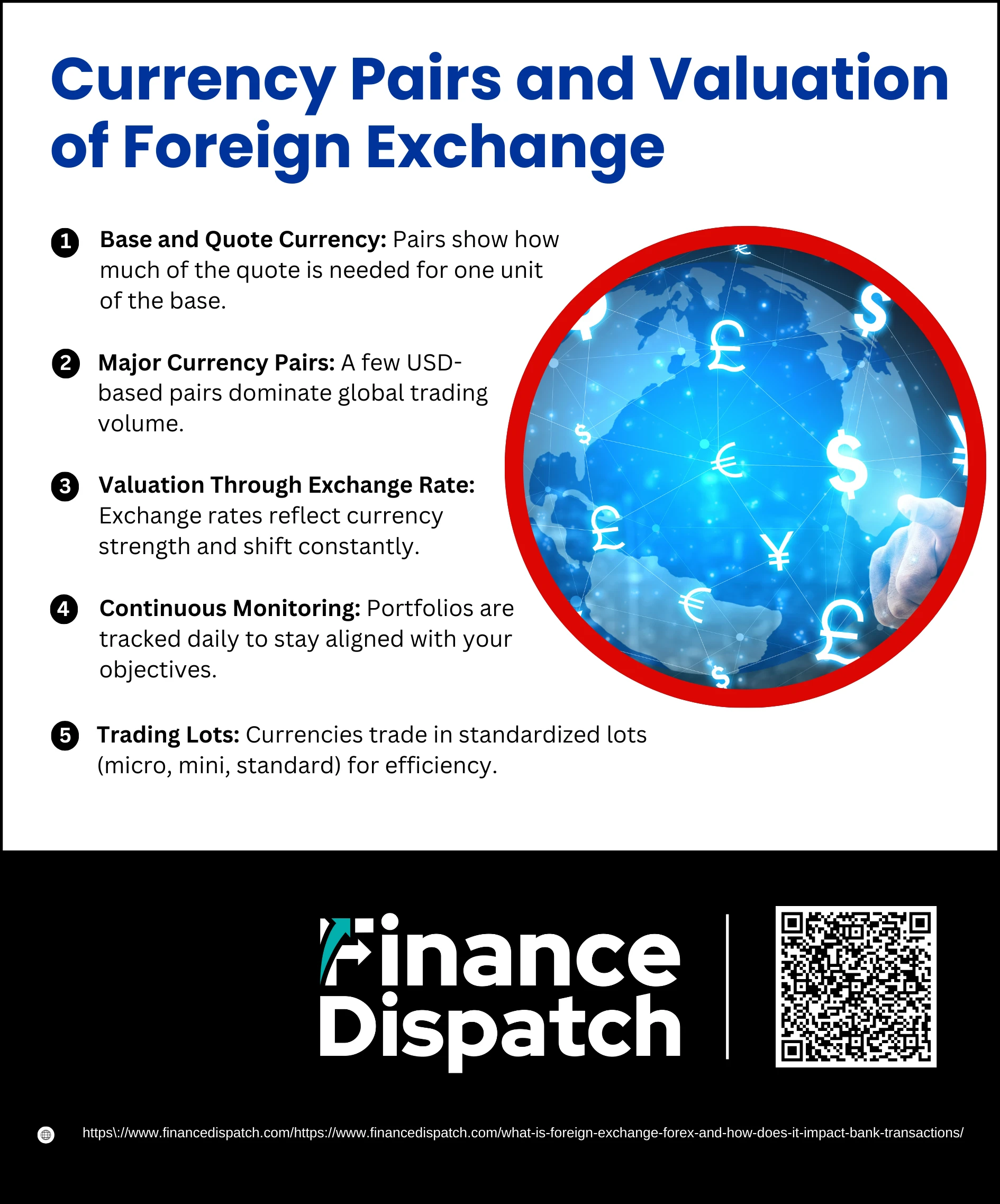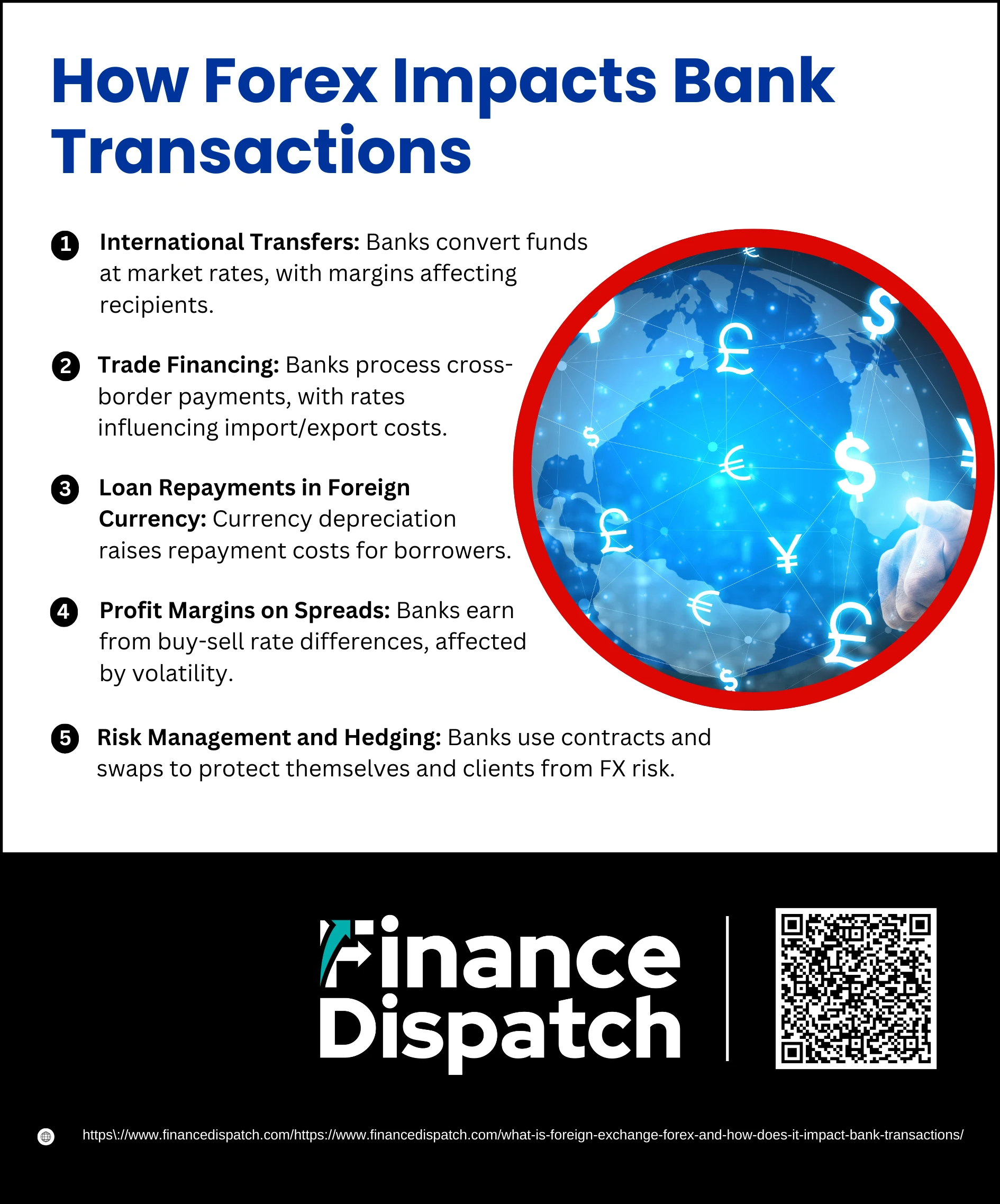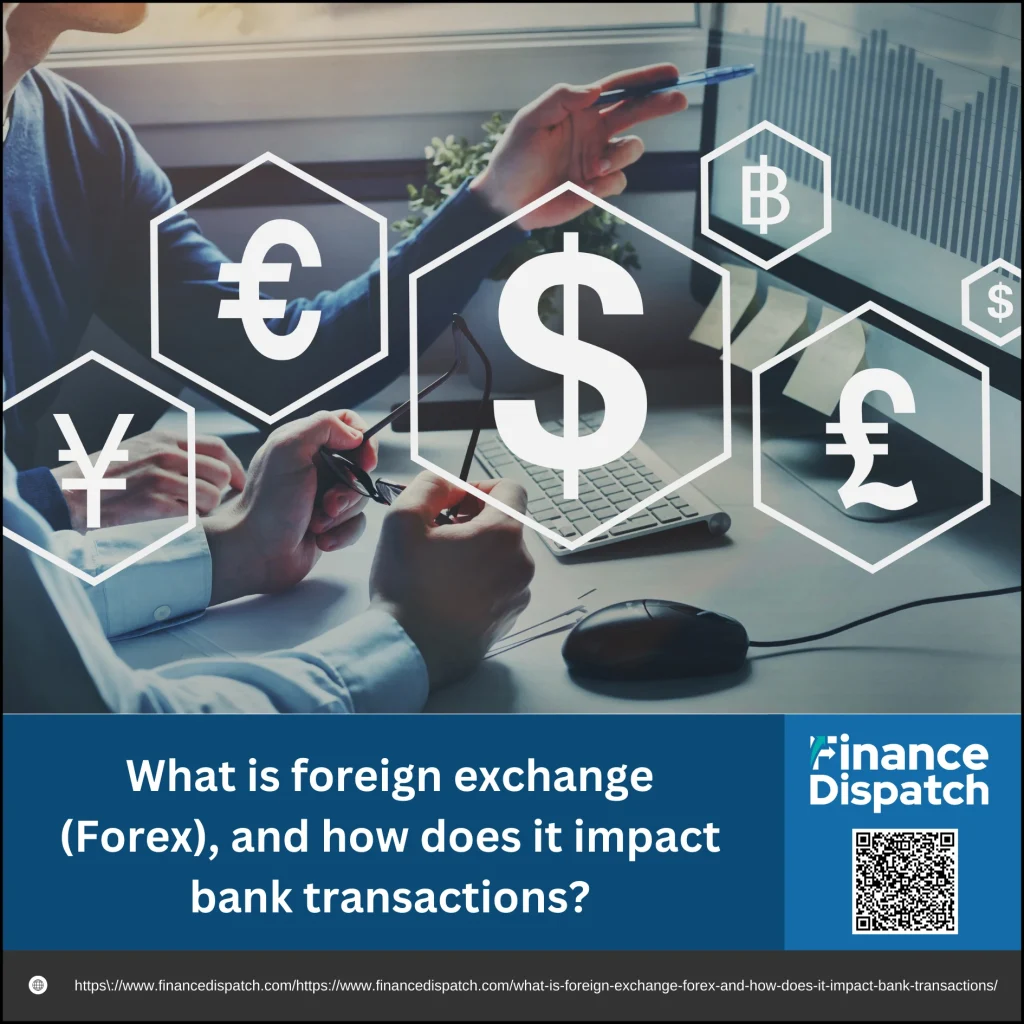Foreign exchange, commonly known as Forex or FX, is the world’s largest and most liquid financial market, where currencies are traded around the clock across global financial centers. Every day, trillions of dollars move through this market, shaping the value of one currency against another. Whether you are traveling abroad and exchanging money at a bank, or a company settling international invoices, Forex silently powers these transactions. For banks, it is more than just a service—it is the backbone of cross-border trade, remittances, and global financial stability. Understanding how Forex works and how it influences bank operations helps reveal its vital role in both the global economy and everyday financial life.
What is Foreign Exchange (Forex)?
Foreign exchange, or Forex, refers to the process of converting one country’s currency into another at prevailing exchange rates. It is a decentralized global marketplace where banks, governments, institutions, and individuals participate in trading currencies. Unlike stock markets that have physical exchanges, Forex operates entirely over electronic networks, making it accessible worldwide. The value of each currency is determined by supply and demand, with factors such as trade, investment, interest rates, and political conditions constantly influencing its price. In simple terms, Forex enables the smooth flow of money across borders, supporting international trade, travel, and investment.
 How Does the Forex Market Work?
How Does the Forex Market Work?
The Forex market operates as a decentralized and electronic system, allowing currencies to be traded globally without a central authority. It is highly dynamic, with participants buying and selling currencies around the clock, making it the largest and most liquid market in the world. Here’s a closer look at the main features of how it works:
1. Decentralized Trading
Unlike stock exchanges that have a physical location, the Forex market has no single headquarters or governing body. All trades occur over-the-counter (OTC) through electronic networks of banks, brokers, and institutions. This structure allows for seamless global participation without strict trading hours or centralized regulation.
2. Market Participants
A wide variety of players drive the Forex market. Banks and central banks handle cross-border settlements and influence currency values. Corporations use Forex for international trade payments, while institutional investors and hedge funds seek profit opportunities. In recent years, individuals have gained access to Forex through online trading platforms.
3. Currency Pairs
Currencies are always traded in pairs—one is bought while the other is sold. For example, in the EUR/USD pair, if you buy, you are purchasing euros while selling dollars. The value of each pair reflects how much of one currency is needed to buy a unit of the other. This system ensures that every trade involves two currencies simultaneously.
4. Continuous Operation
The Forex market runs 24 hours a day, five days a week, thanks to its global nature. When trading closes in one region, another opens. The cycle begins in Asia (Tokyo, Singapore), moves to Europe (London, Frankfurt), and then to the U.S. (New York), before returning to Asia. This “follow-the-sun” model ensures constant liquidity.
5. High Liquidity
With an average daily trading volume of over $7 trillion, Forex dwarfs all other financial markets. This high liquidity means trades can be executed quickly and in large volumes without significantly impacting prices, making it attractive for both banks and traders.
6. Profit Opportunities
Many participants engage in Forex to profit from currency fluctuations. Traders analyze short-term movements using technical charts, while others focus on long-term fundamentals like interest rates and economic growth. By predicting whether a currency will strengthen or weaken, traders can earn profits—but also face significant risks.
 Currency Pairs and Valuation of foreign exchange
Currency Pairs and Valuation of foreign exchange
Foreign exchange works on the principle of trading one currency against another, so currencies are always quoted in pairs. This allows traders, banks, and businesses to understand the relative value of money across borders. The pair format ensures that when one currency is bought, another is sold simultaneously, making it a true exchange.
1. Base and Quote Currency
Every currency pair consists of two parts: the base and the quote. The base is always listed first and has a value of one unit, while the quote shows how much of that currency is needed to buy one unit of the base. For example, if the EUR/USD pair is trading at 1.12, it means that €1 (the base) costs $1.12 (the quote). This format makes it easy to compare the relative value of two currencies.
2. Major Currency Pairs
The Forex market is dominated by a handful of currency pairs known as “majors.” These include EUR/USD, USD/JPY, GBP/USD, AUD/USD, USD/CAD, USD/CHF, and NZD/USD. Because they involve the U.S. dollar and other leading global currencies, they represent the majority of trading volume worldwide. Their popularity comes from high liquidity, tight spreads, and their connection to strong, stable economies.
3. Valuation Through Exchange Rate
The exchange rate reflects how much of the quote currency is needed for one unit of the base. When the rate goes up, the base currency strengthens; when it goes down, the base weakens. For instance, if USD/CAD moves from 1.25 to 1.30, it means the U.S. dollar has become stronger because it now takes more Canadian dollars to buy one USD. Exchange rates constantly change due to factors like interest rates, inflation, trade balances, and political events.
4. Pips and Spread
A pip, short for “percentage in point,” is the smallest unit of change in a currency pair’s price, usually at the fourth decimal place. For example, if GBP/USD rises from 1.3500 to 1.3501, that’s a one-pip increase. The spread, on the other hand, is the difference between the bid (selling price) and ask (buying price). This spread is how brokers and banks often earn their revenue from Forex transactions, making it an essential concept for both traders and financial institutions.
5. Trading Lots
Currencies are not traded in single units but in standardized amounts called lots. A micro lot equals 1,000 units, a mini lot equals 10,000 units, and a standard lot equals 100,000 units. This structure helps banks and traders manage large transactions efficiently. For instance, when a bank executes a foreign payment on behalf of a corporate client, it might do so in multiple lots to balance cost and exposure.
Types of Forex Transactions
The Forex market offers several ways to exchange currencies depending on the purpose of the transaction and the level of risk management required. While individuals may only encounter basic currency exchanges when traveling, banks and businesses often use more complex instruments to manage international trade and protect against fluctuations.
1. Spot Market – The simplest form of Forex, where currencies are exchanged at the current market rate (spot rate). Settlements usually occur within two business days, though USD/CAD settles in one.
2. Forward Market – A contract to exchange currencies at a future date using a pre-agreed rate. This helps businesses lock in costs and hedge against unfavorable currency movements.
3. Futures Market – Standardized contracts traded on exchanges like the Chicago Mercantile Exchange, where participants agree to exchange a set amount of currency at a specified date and price. Often used by companies to hedge large international transactions.
 How Forex Impacts Bank Transactions
How Forex Impacts Bank Transactions
Foreign exchange is deeply embedded in modern banking operations. From handling cross-border payments to protecting clients against volatility, banks depend on the Forex market to manage financial flows efficiently. Changes in exchange rates can either benefit or burden both banks and their customers, making Forex a critical factor in daily transactions.
1. International Transfers
When individuals or businesses send money abroad, banks must convert the funds into the recipient’s local currency. The conversion rate is determined by the prevailing Forex market. Even small fluctuations can change the amount received, which matters significantly for large transfers. Banks often charge a margin over the interbank rate, meaning that customers indirectly experience the impact of market movements.
2. Trade Financing
Importers and exporters rely on banks to process payments for goods and services across borders. For example, if an importer in India must pay a U.S. supplier in dollars, the bank facilitates the conversion of rupees into dollars at the current Forex rate. A weaker local currency increases the cost of imports, while a stronger one lowers it. Banks must carefully manage these transactions, as they directly influence the profitability and competitiveness of their clients’ businesses.
3. Loan Repayments in Foreign Currency
Companies often borrow in foreign currencies to benefit from favorable interest rates or access global capital markets. However, if the borrower’s domestic currency depreciates, the cost of repaying the loan increases. Banks are exposed to this risk as lenders, and they may offer hedging products like forwards or swaps to reduce the impact. This shows how Forex movements can reshape a bank’s credit exposure and repayment planning.
4. Profit Margins on Spreads
Banks generate earnings from the spread—the difference between the buying and selling price of a currency pair. For example, if the bank buys euros at 1.1000 USD and sells them at 1.1020 USD, the 20-pip difference becomes profit. Market liquidity, volatility, and demand all influence spreads. During stable conditions, spreads are narrow, but during volatility, they widen, allowing banks to earn more but also exposing clients to higher transaction costs.
5. Risk Management and Hedging
Banks not only face their own foreign exchange risk but also help clients manage theirs. They use tools such as forward contracts, swaps, and currency options to lock in exchange rates or protect against adverse movements. For instance, a bank might help an exporter guarantee a future dollar payment at a fixed rate, shielding them from potential currency depreciation. Effective risk management strengthens banks’ reliability while ensuring smoother global trade operations.
Factors That Influence Forex Rates
The value of a currency is never static—it constantly shifts based on economic conditions, political events, and global sentiment. In the Forex market, these factors determine whether a currency strengthens or weakens against others, directly affecting international trade, investment, and banking transactions.
1. Economic Policies and Interest Rates – Central banks set monetary policies, and higher interest rates usually attract foreign investment, increasing demand for a currency.
2. Inflation Levels – Countries with lower inflation rates often experience stronger currencies compared to those with high inflation, which erodes purchasing power.
3. Trade Balances – A country exporting more than it imports typically sees stronger demand for its currency, improving its exchange rate.
4. Political Stability – Stable governments and clear policies attract investment, while instability can weaken a nation’s currency.
5. Market Sentiment and Speculation – Traders’ perceptions and expectations about future economic conditions often drive short-term fluctuations.
6. Global Events – Crises such as pandemics, wars, or natural disasters can disrupt economies and cause sharp movements in currency values.
Role of Banks in Forex
Banks are at the core of the foreign exchange market, acting both as intermediaries for clients and as active participants in trading. They handle everything from individual currency exchanges for travelers to large-scale cross-border settlements for corporations. By providing liquidity, setting spreads, and offering hedging instruments, banks make the Forex market accessible and efficient for businesses and individuals alike.
| Bank Function | Description | Impact on Transactions |
| Currency Conversion | Exchanging one currency into another for individuals and businesses | Enables international travel, trade, and remittances |
| Market Making | Offering bid and ask prices to create liquidity in currency pairs | Ensures smooth trading and stable exchange availability |
| Trade Settlement | Facilitating payments for imports and exports | Supports global trade by completing cross-border deals |
| Hedging Services | Providing forwards, swaps, and options to manage exchange risk | Protects businesses and banks from losses due to volatility |
| Foreign Currency Loans | Lending in international currencies | Expands financing options but exposes borrowers to FX risk |
| Revenue from Spreads | Earning the difference between buying and selling rates | Creates profit margins for banks while pricing transactions |
Pros and Cons of Forex Trading
Forex trading is one of the most dynamic financial activities, attracting both professionals and individual investors worldwide. Its global reach, high liquidity, and round-the-clock operation make it appealing, but the same features also bring risks such as volatility and complexity.
Pros:
1. High Liquidity – Trillions of dollars are traded daily, making it easy to enter and exit positions quickly.
2. 24/5 Market Access – The Forex market operates continuously across time zones, giving flexibility to trade anytime.
3. Low Transaction Costs – Brokers typically profit from spreads rather than high commissions, keeping costs relatively low.
4. Diverse Currency Pairs – Traders can choose from major, minor, and exotic pairs, allowing diversification.
5. Leverage Opportunities – Small capital can control larger positions, increasing potential gains.
Cons:
1. High Risk from Leverage – While leverage amplifies profits, it can also magnify losses beyond the initial investment.
2. Market Volatility – Prices can swing sharply based on news, politics, or economic reports, making trading unpredictable.
3. Complexity for Beginners – Understanding exchange rate drivers requires knowledge of global economics and technical analysis.
4. Speculative Nature – Many traders rely on short-term strategies, which can lead to frequent losses without proper discipline.
5. Light Regulation – Unlike stock markets, Forex lacks strict oversight, exposing traders to risks from unregulated brokers.
Managing Foreign Exchange Risk
Fluctuations in currency values can create uncertainty for businesses, banks, and investors engaged in international transactions. This exposure, known as foreign exchange (FX) risk, can affect profit margins, cash flow, and overall financial stability. To minimize these risks, organizations and financial institutions use a range of strategies designed to protect against unfavorable rate movements.
- Forward Contracts – Lock in an exchange rate today for a future transaction, ensuring cost predictability.
- Currency Options – Provide the right, but not the obligation, to exchange money at a set rate before a specific date.
- Natural Hedging – Match revenues and expenses in the same currency to reduce exposure.
- Diversification – Spread business operations and holdings across multiple currencies to limit risk from one market.
- Swap Agreements – Exchange cash flows or loans in different currencies to balance international obligations.
- Automated FX Platforms – Use digital tools that offer real-time rates, reduced fees, and seamless global transfers.
- Regular Monitoring – Track exchange rate trends and adjust financial strategies to stay prepared for sudden changes.
Conclusion
Foreign exchange, or Forex, is more than just a marketplace for trading currencies—it is the backbone of international finance. By setting exchange rates, it influences the cost of travel, the price of imports and exports, and the way banks manage cross-border transactions. While Forex offers opportunities through liquidity and accessibility, it also carries risks due to volatility and leverage. For banks, businesses, and individuals, understanding how Forex works and managing its risks is essential to navigating the global economy. Ultimately, Forex is not only about speculation but also about enabling trade, investment, and financial stability across the world.



